This article is written by Matt Lerner, co-founder and CEO at Startup Core Strengths, a company that helps Seed and Series A startups accelerate growth with a metrics-driven process of rapid experimentation. Previously, he was an investor at 500 Startups and ran B2B growth teams at PayPal. For more of his insights on growing a startup, check out his newsletter.
Here’s a quick test: Which one of these headlines converted 10X better?

Option B converted visitors to signups 10X better (30%) than the first version (3%). Dozens of times now in my career as an operator, investor and advisor, I’ve seen changes in a handful of words yield jaw-dropping differences in conversion. Here are a few more examples:
What’s going on here isn’t magic, nor is it “just marketing tactics.” It’s language-market fit at work — when you find the exact right words to explain your product or service to prospective customers, words that resonate with goals and struggles that are already in their brains. When you talk about your product, a lightbulb in their heads switches on that says, “That is EXACTLY what I’m looking for” — they feel like you’ve read their minds.
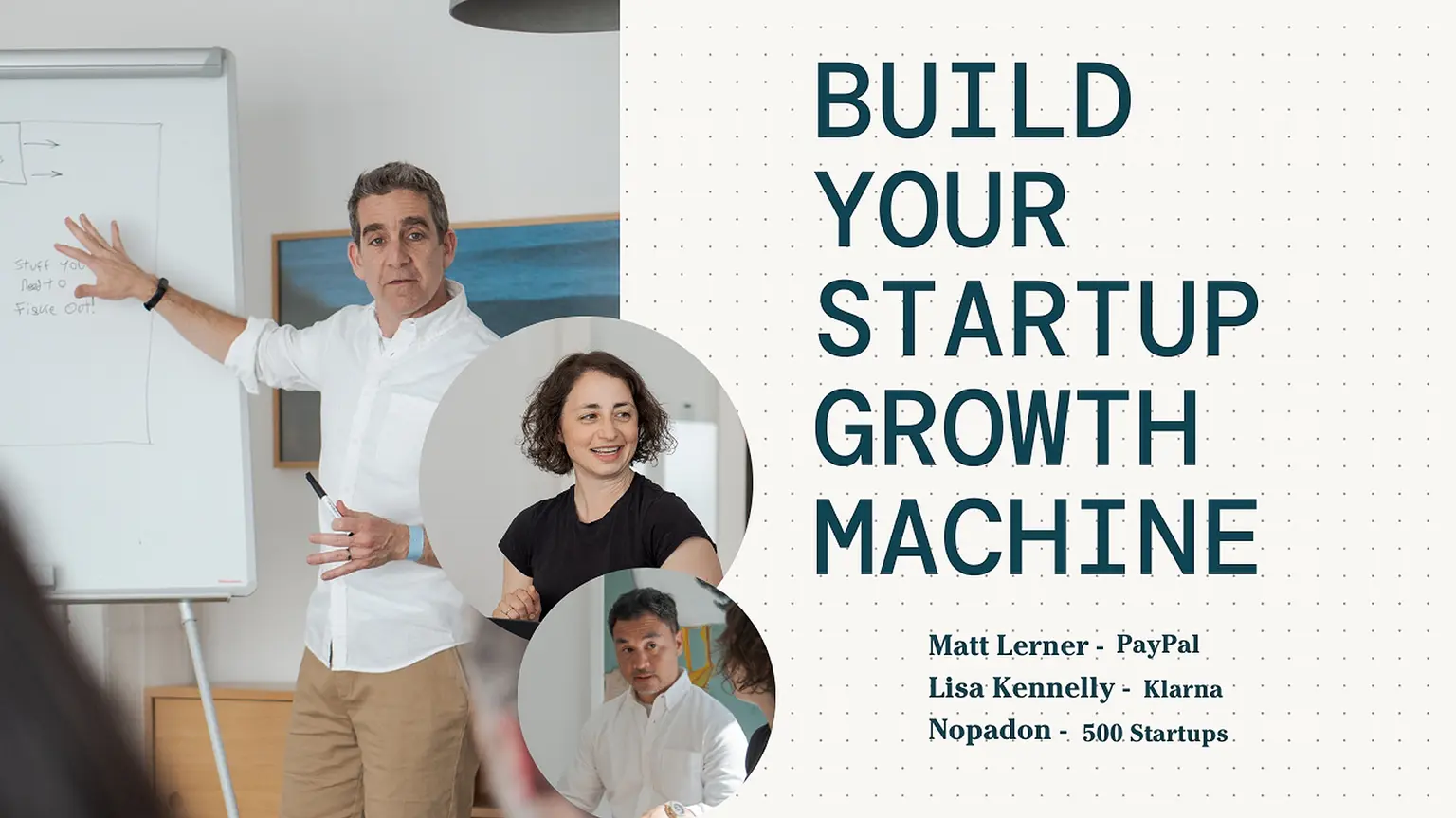
If you like Matt Lerner's advice, consider taking his Build your Startup Growth Machine course on Maven
I myself didn’t realize until I jumped the wall from operator to VC and saw hundreds of early-stage companies, but now it’s clear as day: language-market fit is the most under-appreciated concept for early-stage startups.
For starters, most founders are focused on finding product/market fit, zeroing in on the right set of features to match their prospects’ needs. Moreover, fine-tuning language seems like "marketing," which is usually seen as a later priority, not step zero. Lastly, people also don't tend to like going out of their comfort zone — and for technical founders especially, this work usually is.
Yet there are real costs to not prioritizing this deeper work. Before language-market fit, growth feels like pushing on a string, a lot of work for incremental gains. Your Facebook ads barely pay for themselves and your AdWords don’t. Your marketers struggle to deliver results despite success with previous companies. Your salespeople (other than your founder) struggle to sell your product. And your conversion rates hover between 0.5% and 3%.
On the other side, I’ve seen companies with language-market fit normally get conversion rates from 8% - 40%, which results in much stronger unit economics. Why the sudden jump? Visitors to your site or app store listing bring different levels of intent. It’s easy to convert high-intent users. But if you’re an unfamiliar startup, most of your visitors will have low intent, more curious than desperate. As you tighten up your language, you’ll be able to cut through to that massive pool of low-intent traffic.
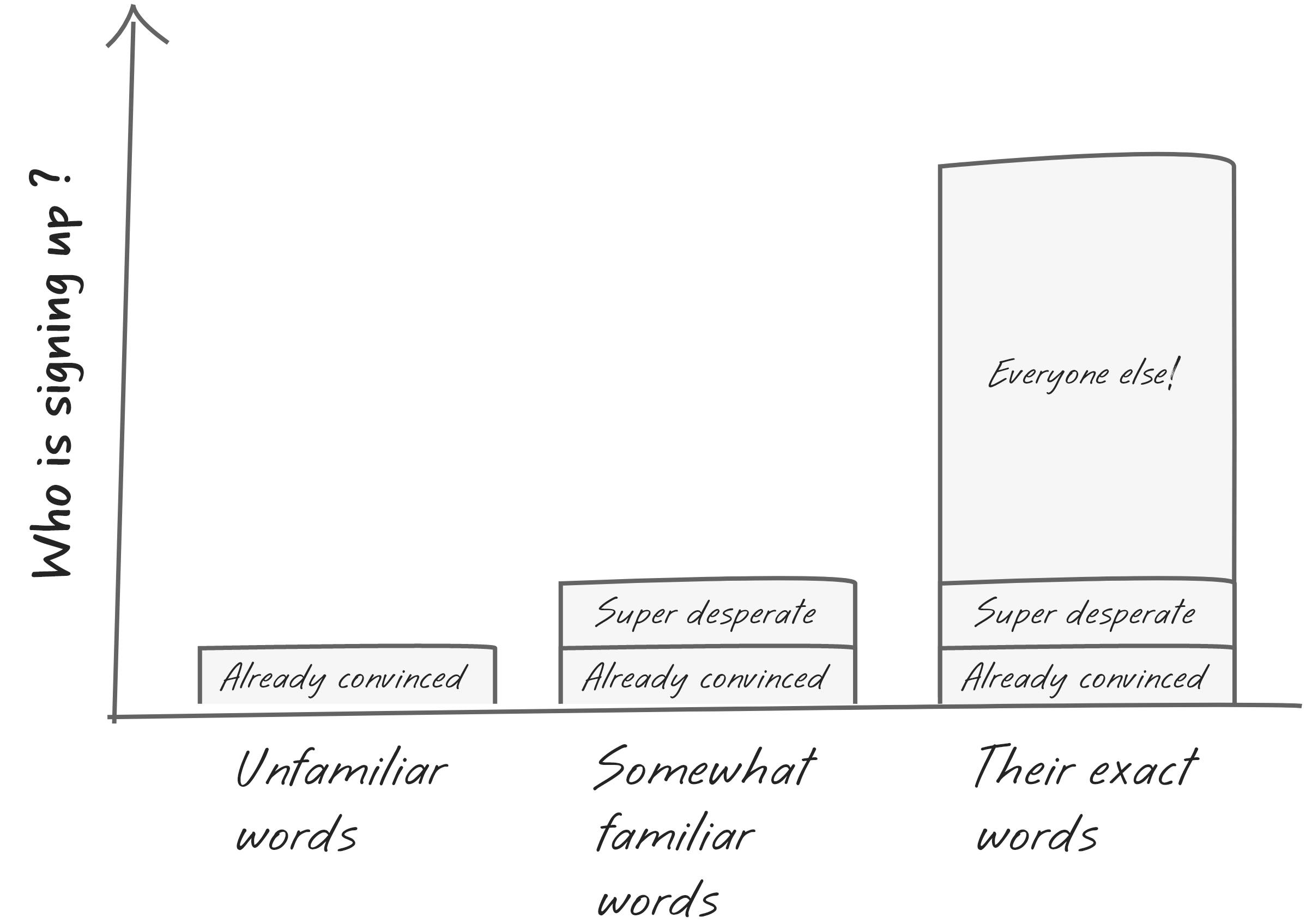
In my view, it’s the “lead domino,” the task that, once you get it right, makes everything easier. While low conversion rates are the most obvious symptom, language-market fit runs much deeper. It helps you understand and size your market, narrow in on what to build, validate demand and demonstrate traction, which can really help with hiring and fundraising. The business impact is abrupt, not gradual. It’s like picking a lock. And when it finally clicks, it’s thrilling.
That’s why the advice I share with founders these days is always consistent: If you do not have language-market fit, put down your tools and go find it. If you’re doing anything else, you’re wasting precious time. Stop whatever you’re doing. Stop chasing product/market fit. Stop pumping money into Facebook and AdWords, stop trying to replace your marketing team. Until you find language-market fit, nothing else will really work. Forget the symptoms. Address the root cause first.
Below, I’ll share more about why finding language-market fit should be “step zero” for startups, explaining the neurological basis for this phenomena and showing, step-by-step, how startups can find it. If you’re a pre-product/market fit founder, or a head of product or growth, this approach can save you a lot of time and wasted cycles.

STEP ZERO: THE CASE FOR STARTING WITH FINDING LANGUAGE-MARKET FIT
My advice for founders is generally to add on the search for language-market fit as a part of the customer discovery process. (There are, of course, examples where that counsel doesn’t apply because language-market fit is less critical in certain contexts, whether it’s a biotech startup creating a new cancer immunotherapy drug, or a pair of co-founders who are building products to scratch their own itch, and thus already know the use case intimately.)
But if that ship has sailed and you’ve already gotten started with building and aren’t finding product/market fit yet, I’d recommend stepping back and looking for language-market fit. Building stuff that doesn’t get any traction is an expensive mistake, in more ways than one. Each new feature adds a slew of downstream effects, from creating tech debt and requiring regression testing for each release, to adding bloat that makes the product harder to use — and the proposition more complicated, and thus, harder to sell.
Starting with language-market fit brings three other big advantages:
- 1. Speed - Product build-measure-learn cycles, even just prototyping, can take weeks. But you can iterate language 5X in a single day.
- 2. Traction - A pre-launch lead-capture site (that markets the product to validate demand) with 25% conversion is a strong signal to potential investors, plus it queues up a product waitlist of potential beta testers.
- 3. Clarity - Most importantly, a clear, validated, plain-English articulation of your value prop really helps the entire team understand what they’re building and why.
That third point is critical: Working backwards, every successful startup creates something that people find truly useful. If you cannot even describe what your customers are trying to do in simple language, how long will it take you to invent a product they will love? With clear validated language, you can improve every aspect of the customer experience.
When you can understand and articulate your customers' goals and struggles and anxieties in simple, precise language, your developers and product teams will not have to guess at what to build.
You can, of course, chase product/market fit with a build-measure-learn loop. But iterating language goes so much faster. Today’s leanest startups test “minimum viable” prototypes, iterating every few weeks. But why spend weeks prototyping when you can iterate and test/validate language in minutes? (I’ll explain that process below.)
But why is the exact language so critical?
When I hear that founders are looking to “educate the market,” I get nervous. In order to educate somebody, you need to fully capture their attention and get them to suspend their current beliefs and consider, adopt and master a new way of operating. I run an education business, and I must say that is a herculean task.
As an unknown startup, it’s hard enough to even get people to read or click on your ads, let alone rewrite their beliefs or change habits.
As you’ve probably noticed, we don’t read startups’ websites the way we read books. Instead of reading each sentence, our attention bounces around, scanning, and occasionally scrolling or clicking. Psychologists call that scanning process attentional control; visitors are deciding if they should invest a few more seconds and direct more of their attention to your website, ad or app store listing or just bounce. That means attention is the first hurdle in your funnel, and probably the one with the biggest drop-off. So how do humans allocate attention?
Psychologists have observed that we switch between two modes of attentional control depending on the situation, and people have an innate preference for one mode or the other. The two modes are:
- 1. Goal-directed (top-down) attention: When you need to find something specific, you have a particular outcome in-mind, and you're looking for things that will help you get there. For example, imagine a sequence of Google searches researching the best supplements and behavioral routines to combat insomnia — that’s top-down.
- 2. Stimulus driven (Bottoms-up): When your mind is focused on the raw sensory input, looking for interesting things, like when you’re scrolling through your Instagram feed, that’s bottoms-up.
(No, I do not think it’s a coincidence that the two dominant media properties on the internet, Google and Facebook, align perfectly with the two modes of attentional control in human cognition — goal-directed and stimulus-driven.)
Unless your goal is capturing and holding attention for its own sake, like Buzzfeed, you’re probably trying to get their attention as a means to an end, so you can sell them a product or service. Therefore, we’ll focus on unpacking top-down, goal-directed attention.
Goal-directed attention involves a rapid pre-conscious, first-fit pattern-match. That means we have this very specific target in-mind and we’re looking around searching for a close match. (Imagine rummaging through your cutlery drawer for the garlic press.) So every site visitor has a particular goal in-mind, and they take quick snapshots of information and compare them to that target to see if it’s on-goal or off-goal? Getting warmer or colder? That’s how they decide between “keep scrolling,” “click here,” or “back button."
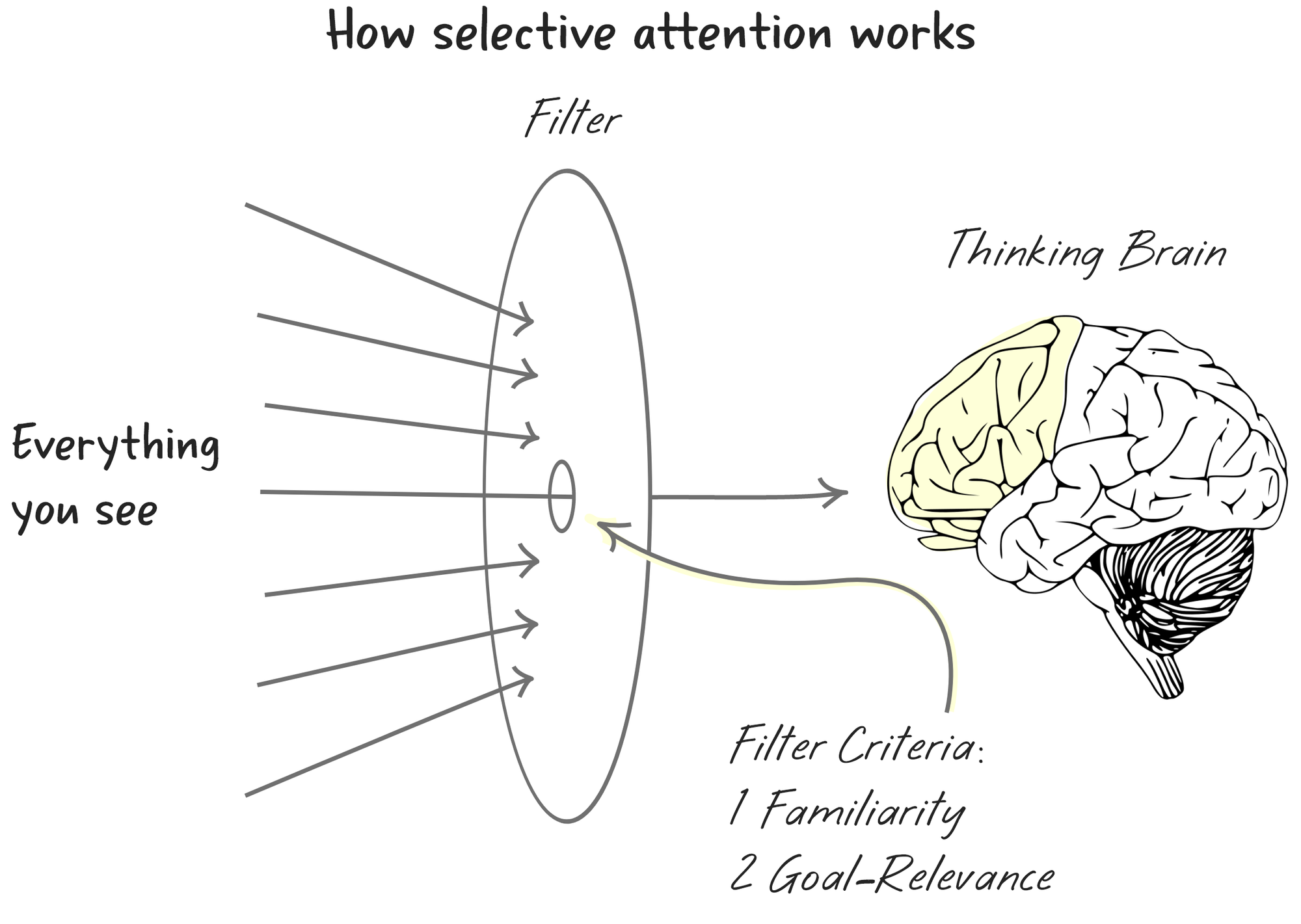
Psychologists call this information foraging, because it resembles the way our ancestors (and all vertebrates really) looked for food in the wild. Animals have a particular stimulus in mind, like a banana, and they’re quickly pattern-matching against it to direct attention and movement.
Prospects looking at your ads and checking out your site are probably not, in the first instant, thinking or reasoning. They’re foraging, literally doing a subconscious pattern match to see if your offering “looks like food.”
This process takes nanoseconds. In order to win them over and get them to invest a bit more attention to ponder your features or pricing, first you need to get past this triage and “look like food.” Therefore, you need to understand the target in their brain. In other words, you need to read their minds.
This effect is obvious in paid search. When people buy search terms, click rates are higher if the ad copy exactly matches the search query syntax, rather than a paraphrase. (See this quick example below.)
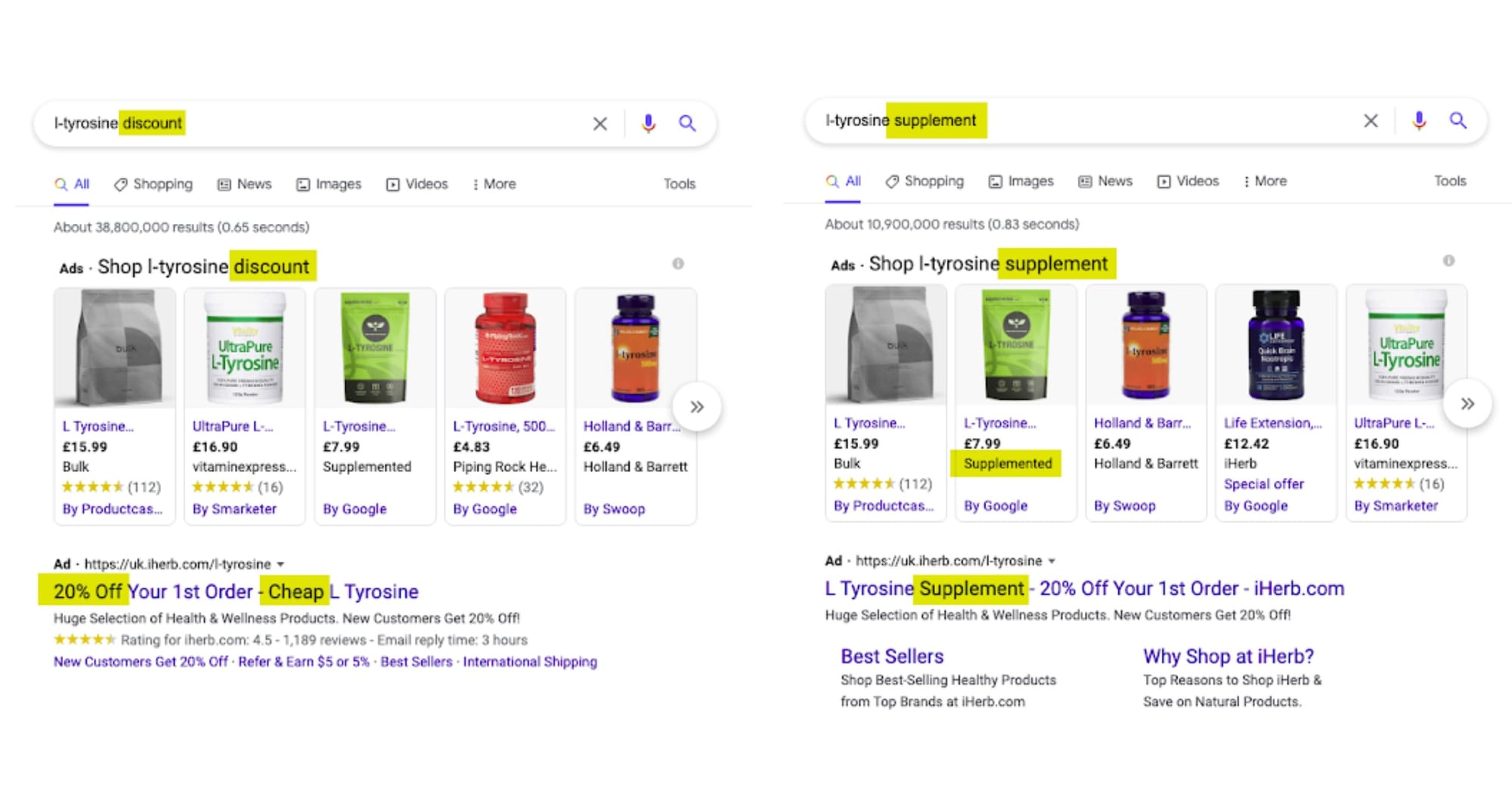
HOW TO FIND THE LANGUAGE THAT PICKS THE LOCK (OR WHY NOBODY WANTS YOUR “ALL-IN-ONE SOLUTION.”)
So what’s in your prospects’ heads? If you could stop people in the middle of their day and snapshot-read their minds, what would you find? You would not find a list of product features or marketing platitudes. You would see anxieties, fears, doubts, hopes, dreams and struggles. Therefore the best way to get past the attention filter is to talk about the stuff that is in their heads — specific goals, struggles and doubts.
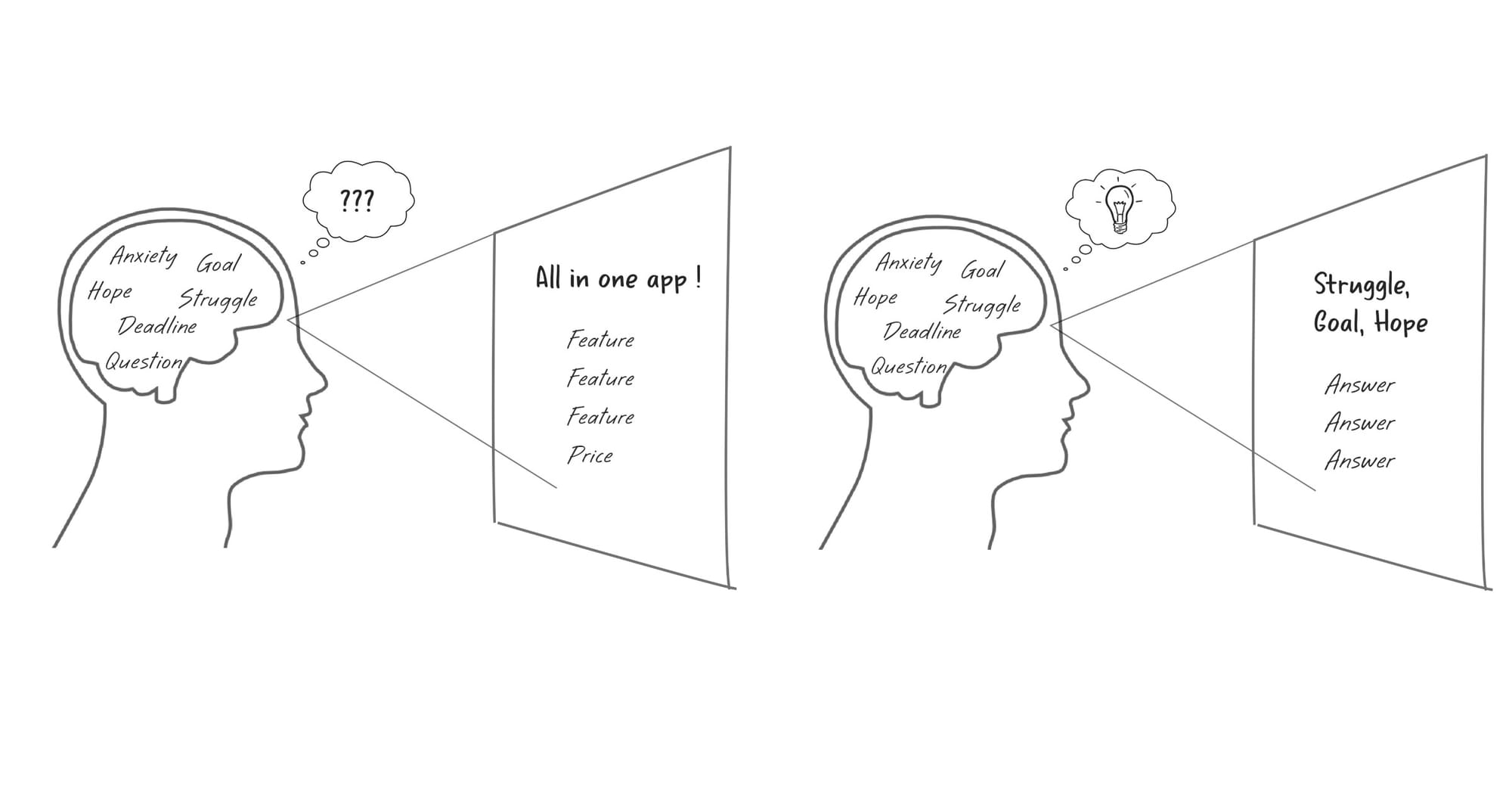
A simple test: If your headline completes the sentence “Our product is…” You’re not using their words. If your headline completes the sentence “Now you can ______” or “I wish I could _____” or “Someday I hope to _____” then your language might resonate. A good marketer will fill that “now you can” blank with exactly the right words. A few proven examples:
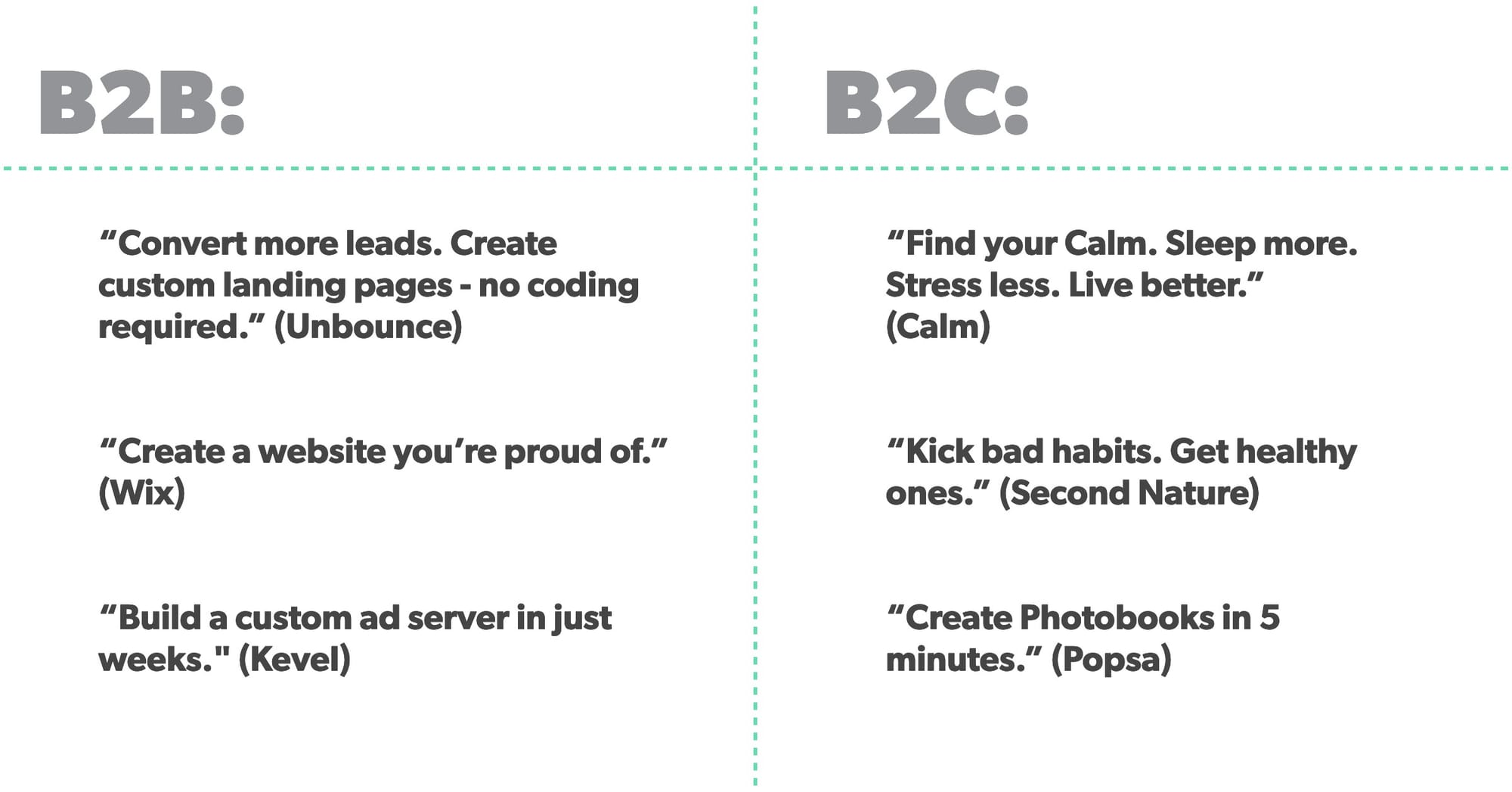
So how do you find your right words? Our answer comes from Clayton Christensen at Harvard Business School, author of "The Innovator’s Dilemma," and Bob Moesta of the Rewired Group, who developed a theory called “Jobs To Be Done.” (JTBD).
Jobs theory posits that we do not actually “buy” products or services, we hire them to do jobs for us, the way we might hire a contractor, to help us make progress in our lives. That may sound like an esoteric distinction, but it’s critical.
What seems like a simple purchase decision sits within a larger context in the customers' lives. And as marketers, that context is critical, because the words in their heads will reflect their situation rather than your product.
Therefore, the better we understand that context, the more effective our product and marketing teams will be. Traditionally “jobs interviews” are used by product managers, but when we work with companies as part of Startup Core Strengths, we find the jobs-to-be-done interview technique can also form the basis for your marketing. Since our focus is language, we’ll capture the specific words people use to describe their struggles and desired outcomes, plus of course the social and emotional aspects of the job.
Use this four-step process to unlock language-market fit:
We help companies find language-market fit with these four steps:
- 1. Uncover the struggles, hidden assumptions and goals via interviewing recent sign-ups
- 2. Draft some test messages based on the interview transcripts
- 3. Validate comprehension qualitatively
- 4. Finally, test the language quantitatively
1. Uncover their goals, struggles and language
Before we can sell somebody a product, we first need to understand how it will fit into their lives — what they are trying to do. Christensen calls that the “job.” And with his collaborator Bob Moesta, he came up with a very specific interview technique to uncover that context:
- Find somebody who has recently purchased your product. If your product has not yet launched, interview someone who bought a competitor's product, used a workaround, or asked for “alternatives to” on Twitter. In other words, find someone who has recently invested time and money to make progress on the thing you help people do.
- Ask them to walk you through the purchase process from the very beginning. When did they first realize they were struggling with that goal? Walk through their journey, step-by-step.
- As they recount their journey, ask questions to understand what they were struggling to do, where they looked for help, and which alternatives they tried. Questions like: What will this purchase allow you to achieve? Why is that important to you? Describe when you first thought of buying something like this — what were you trying to do? What were you using to do this before? What options did you consider first? Where did you look for ideas or help?
- As they go, politely interrupt them to clarify two things: 1) When they use a vague term like “better,” “flexible,” “convenient,” or “all-in-one” ask them to unpack it for you. “What does ‘better’ mean to you in this context?” 2) Ask probing questions to uncover causality - e.g. "do you remember why you decided to go to that store on that particular day?” or “You just said you’d been having sleep problems for 14 months, what prompted you to buy a new mattress on that particular day?”
That’s it. There are no right or wrong answers, just ask them to talk you through it as though you were making a documentary film. Listen for their goals and struggles, and any alternative solutions they may have tried. Watch for emotions and encourage them to explore their feelings. As they speak, make sure to capture their exact words.
If this seems overwhelming, we created these interview “cheat sheet” cards with question prompts, which simplify the process. Also, to watch a hands-on demonstration of how to run a Jobs interview, check out this workshop run by Bob Moesta and Chris Speck.
Even after just five interviews you should start to see patterns. (Though there’s no harm in doing more!) Returning to the first example at the very beginning of this post, Mindstone founder Joshua Wöhle literally text-mined their interview transcripts, using a text analysis tool to pull out all the verbs that his customers used. He found the most common ones, pulled out the surrounding words for context, and used that language to craft his 10X headline.
2. Next, draft some headlines.
From your interviews, you should have a list of people’s goals (“I want to…” “I wish it were easier to…”) and struggles (“I hate it when… I’m tired of… Why can’t I just…”)
Pull out the ones that you think will resonate with most of your prospects, and write them up as headlines that complete the sentence “Now you can…” (Customers will normally say “I was trying to” or “I needed a tool that could…” Those sentences can easily flip into “now you can.”) For example, imagine the words “Now you can” before any of my earlier examples:
- “Build a custom ad server in just weeks." (Kevel)
- “Increase app store conversion rates and pay less for every install.” (Storemaven)
- “Create Photobooks in 5 minutes.” (Popsa)
- Organize, share and take notes on web pages, PDFs and academic papers easily, so you can learn faster, remember more and get things done. (Mindstone)
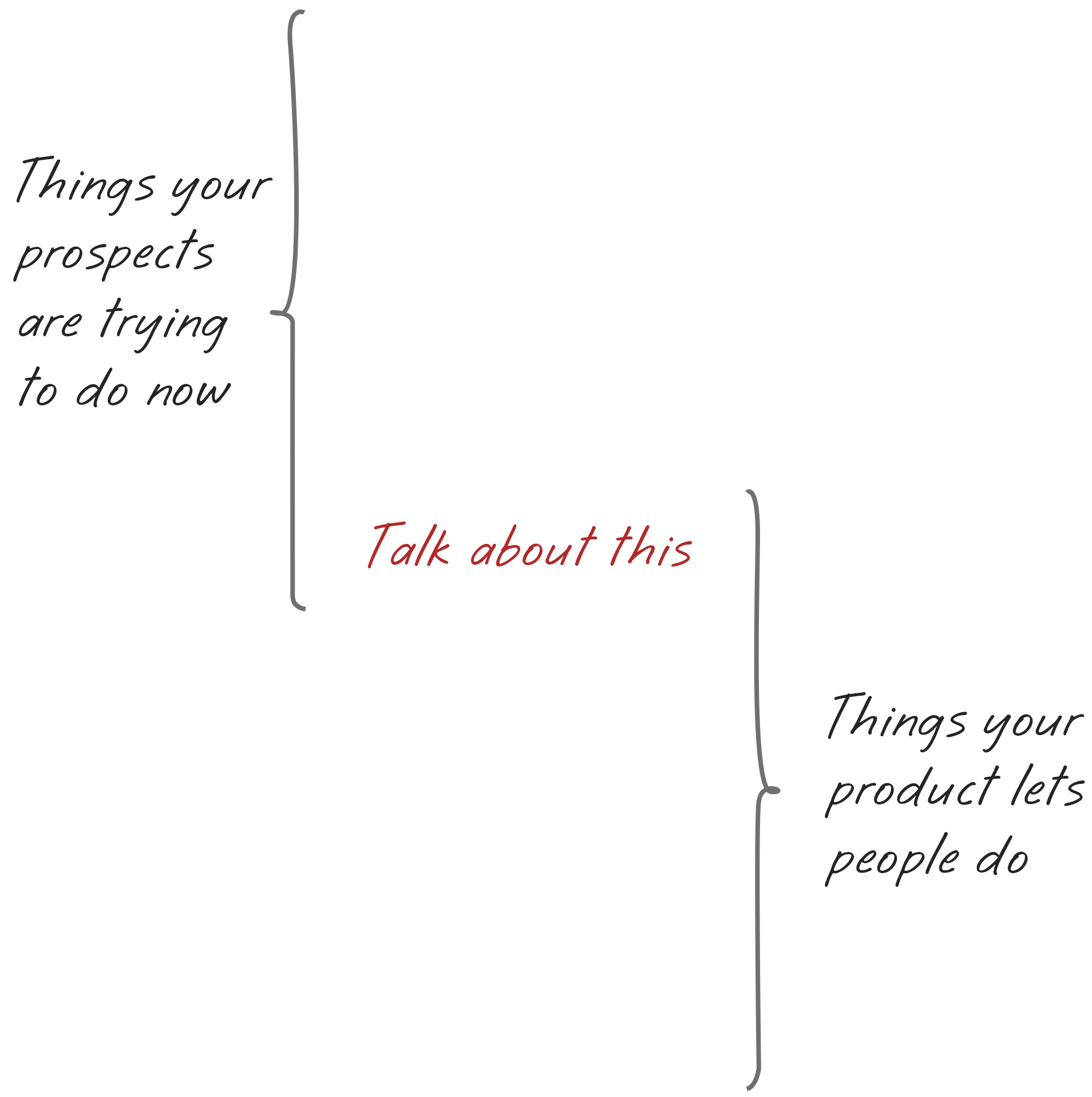
Here are a few more tactical tips to keep in mind as you’re drafting:
- Stick to “I” not “you” struggles. Most of the headline examples here describe the goal (e.g. Create a website you’re proud of). In some cases, if people are aware of the problem but reluctant to act, such as weight loss or personal finance, you’ll find more success talking about the struggle first in the headline. If you want to try some “struggle” headlines, write in the first person (I rather than “you”), and avoid rhetorical questions. For example: “I’m tired of getting screwed by my bank” (feels better than “Are you tired of getting screwed by your bank?”) and “None of my clothes fit anymore, and I think about food constantly.” (Feels much better than “Are you getting too fat for your clothes? Are you obsessed with food?”) If you go this route, follow up the “struggle” statement with your “now you can” goal statement as a sub-headline.
- Avoid vague platitudes or anything that sounds like marketing, such as “all in one,” “faster,” “revolutionary” or “convenient.” These platitudes engender cynicism, and people will not infer what they mean. It forces prospects to either guess at what you do or take your word for it that you're awesome — which they’re unlikely to do, given that your promises will “sound like marketing.” Instead, focus on specific goals and tasks.
- Stay specific. On a related note, we tend to say stuff like "all in one" because we don't know which benefits to talk about. This is particularly acute when we’re trying to appeal to a broad audience. But if you really understand the customers' goals and struggles, you can usually find a message that's quite specific but still has broad appeal. For example, I worked with a compliance SaaS startup that targets Fintech companies, commercial real estate, corporate HR and lawyers (quite a broad set!). The winning messages that resonated with all prospects were not watered down, but rather specific angles like "I hate asking people for a copy of their passports" and "I'm not ready for an audit."
3. Validate comprehension
A/B testing can tell us which headline gets more clicks, but it cannot show us why. Therefore, before you start A/B testing different options, it’s critical to make sure your words mean what you think they mean when prospects read them.
For example, if I advertised an “all-in-one video solution” which product would that be? YouTube? Tik Tok? Camtasia? iMovie? Final Cut Pro? Netflix? I cannot honestly guess. But if I said “automatically add subtitles to your videos before you publish them to social media” you’d have a much better idea of what we’d help you do.
Validating comprehension is quite simple: First, type out each headline on a presentation slide or in a document in a large clear font (no design needed). You can run this test on your laptop screen, over Zoom, or even using printouts.
Next, find somebody to test it on — it can really be anyone unless your industry has specialized jargon. Explain that you’re working on some new messaging and would like to run it past them if they could spare one minute. (I normally walk to the cafe area of my co-working space, or run it at the beginning of a Zoom call whilst waiting for stragglers to arrive.)
Tell your volunteer there are no right or wrong answers, just whatever the message means to them. Open your laptop (or take out the sheet of paper), and show it to them for five seconds, then, without warning, take it away. (Why only five seconds? Remember — this is all about the lizard brain! People are not going to study your website. They either get it or they don’t. So don’t warn them that they will only have five seconds, just close the laptop.)
Next, ask them a few questions:
- “Do you recall what that said?” (Could they read the words correctly? Many people don’t actually read, they scan and skip long confusing words.)
- And what do you think that is? What would it do for you? (Checking how they interpret the words). If they just repeat the headline back to you again, they probably didn’t understand it.
- Ask them to explain in their own words - “But what do you think that means?” (If they still don’t understand it, your visitors won’t either!)
Repeat this process 4X for each headline. Take the feedback, iterate, and test your new language. If you’re not sure how to phrase something in “normal people language” try a Google search for the phrase. If you scroll down to the bottom where it says “people also searched for…” you may find some more popular synonyms. You can also double-check language using a keyword tool like SEMRush or Ubersuggest. For example, I once worked with a stock trading app (or so I thought). But our keyword research showed that the search volume for “investing app” was 2X higher than “stock trading app.”
Repeat this process until people really understand your headline and subhead. (You should be able to get through four iterations in an afternoon.)
4. Run this quant test
Next you want to test your new headline(s) against your current option. Landing page A/B tests take too long unless you have a lot of traffic, so it may be quicker to test messages in ad impressions, for example on Facebook or Instagram. Create several copies of a simple ad design, and run that same ad with different headlines, and see which one performs best with your audience. Even if you don’t quant-test these, you’ll have a lot more success even just doing steps 1-3.
That’s it! If you’re struggling to find product/market fit, stop hiring, stop coding. Go figure out what “looks like food” to your prospects and lock in language-market fit first. It makes everything else easier.
One final warning: Your agency will hate this
Your marketers and your agency will call these messages boring, derivative and functional. Because every marketer wants to write the next “Just Do It” or “Think Different.” (And who can blame them?) But here’s the problem: Nike and Apple already built ubiquitous awareness and comprehension, so their ads can be ephemeral and allusive. They earned that right over decades. Your innovative little startup did not (yet). So you need to start with clear functional messaging until people understand what you can help them achieve. Take heart, even Nike and the iPhone started out with boring functional messaging in the beginning (see below).
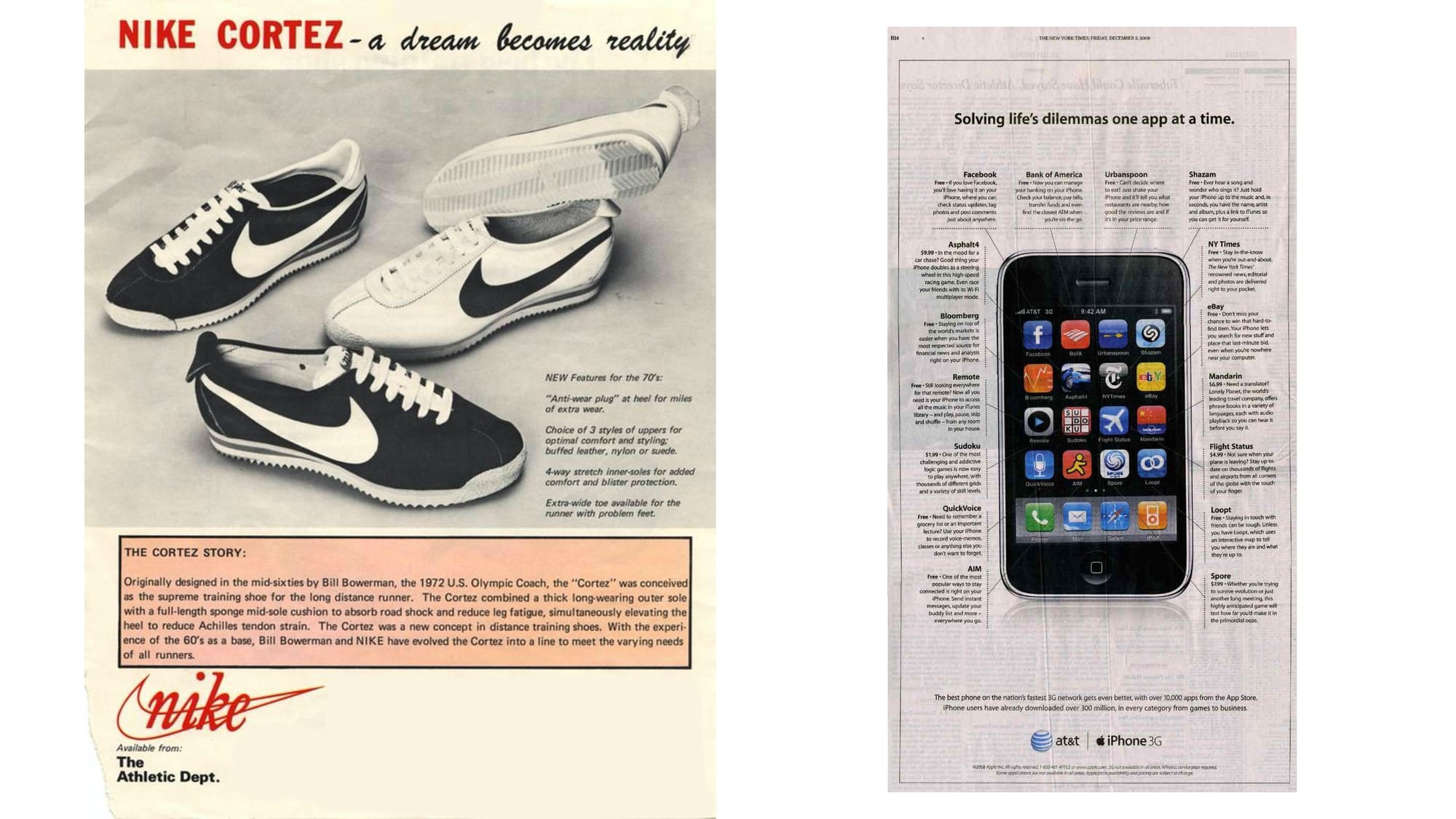
Thanks to Hiten Shah and Ellen Fishbein for your incredibly valuable feedback on earlier drafts, and to Dr. Michael Halassa at MIT for patiently reviewing and correcting the neuroscience!
Cover image by Getty Images / Eskay Lim / EyeEm.
